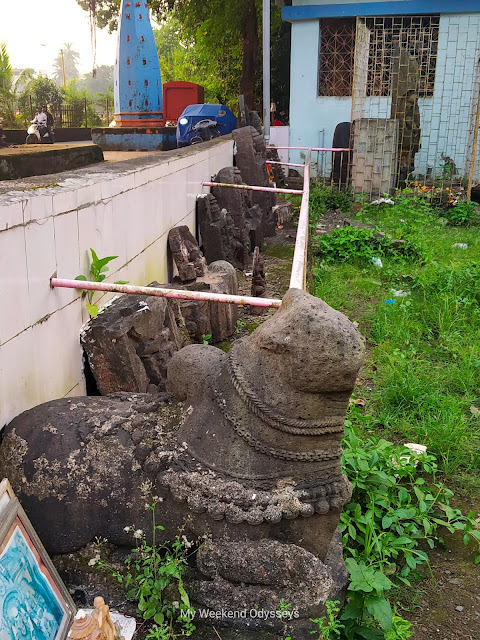Chakreshwar Mahadev : A temple with treasure trove of masterpiece sculptures and relics.
The name Chakreshwar Mahadev doesn't ring a bell instantly and many may have never heard of it. But talk to archaeologists or heritage enthusiasts and they will speak highly of this temple. No one knows of the exact date of construction of the original temple but it is generally believed that it could be 1000 years old. The original temple is said to have been destroyed and plundered during the Portuguese rule of Bassein and the new construction is modern and utterly ugly. The treasure trove of sculptures and relics in the temple compound makes it stand out and an important heritage that needs to be preserved.
So where is this temple? Chakreshwar Mahadev temple is located in Sopara village which we know today as Nalasopara. Sopara was also known as Shurparaka (city of brave), It was an ancient port city and a trade center with links to other ancient cities of the world like Mesopotamia, Greece, Rome, Africa among others, and an important seat of Buddhism. It gets a mention in Mahabharata as a holy place where Pandavas rested en route from Gokarna to Prabhas Patan in Gujarat. Sopara was also the capital of the Satavahana empire (around 4th and 5th BC). The excavated ruins of grand Buddha Vihara in Sopara were built by a local merchant and follower of Buddha and are said to have been inaugurated or visited by Gautama Buddha himself. The Chakreshwar Mahadev temple is located at a walkable distance from the vihara opposite the lake by the same name.
Chakreshwar Mahadev temple shares a common compound with other shrines of Hanuman temple and a Lord Ram temple, located in Joshiwadi. Tucked in one corner lies a very dilapidated structure with the roof covered in tarpaulin. The board on the entrance says Ram Mandir and the date as "sake 1814" which means this temple was built in 1892.
The interiors of the temple are quite peaceful and clean, with wooden pillars and beams. Those wooden brackets on the pillars look quite attractive. In the sanctum lies the idols of Lord Ram, Laxman, and Sita.
On the side of the temple, there is a small verandah where it is said that disciple of Swami Samarth of Akkalkot fame - Shree Mayuranand took a sajiv samadhi at this very place. Swami Samarth is also said to have visited this temple during his lifetime.
Two idols are embedded into the walls on both sides of a small shrine in the verandah. Take a closer look and you understand the intricate work done in stones. One of the idols is that of Goddess Kali killing a demon under her feet and holding a weapon, while the other idol is that of Varaha avatar of Lord Vishnu.
Outside the math and lined against the half wall lies stone sculptures and relics which is the real treasure trove that this temple holds. Some of these sculpture has no comparison, such is their uniqueness. Legend has it that they were part of the original temple which was plundered by the Portuguese and the stone relics and idols were either thrown in the nearby lake or immersed in it to avoid being destroyed. They have been carefully retrieved and now lie here in the temple compound.
There is Gajalaxmi - The goddess Laxmi with two elephants on each side and three different hero stones which are memorials for warriors who died in some battle.
There is a stone sculpture of two ladies, a huge Nandi in stone with a couple of necklaces carved around its neck, a very unique and large "Ek Mukhi Shiva Linga" and few remnants of old temples.
Hari Hara is a fused representation of Lord Vishnu as Hari and Lord Shiva as Hara. The exquisitely carved idol is rare to find, dedicated to this supreme god which is revered by both Vaishnavites and Shaivites.
The main attraction among all the idols and one of the rarest of the rare idol is that of Vishwakarma or form of Brahma. Words fail to describe the magnificence of the idol. The stunning idol of Brahma has three faces with one of them having a beard, hands holding Vedas, kamandalam, and a lamp. The Brahma idol is in a standing pose also known as equipoise state which means it may have been the main idol of the original temple.
As we move inside the main Shiva temple, we have the Shiva Linga in the main sanctum of the temple but apart from it there are a few more intricately carved stone idols among them is an idol of Lord Surya with horses as his vehicle.
There is Uma - Maheshwara idol (Shiva and Parvati) and Ganesha.
Lord Vishnu idol and some goddess.
And there is yet another masterpiece. A voluptuous yogini with a parrot in hand. All these stone idols are intricately carved and each one is a masterpiece.
It was quite an overwhelming experience to see these extremely beautiful sculptures in stone and I cannot fail to visualize how grandeur the original temple would have been with all these intricately carved masterpieces in one place. Chakreshwar Mahadev temple and Nalasopara Buddhist shrines should be on everyone's must-visit places in Mumbai.
Any heritage enthusiast wanting to explore nearby attractions can further visit the beautiful Vishnu idol of Karmale village, check my blogs (Vishnu idol at Karmale village), the ancient port town of Agashe, (Agashe heritage walk) and also explore the island fort of Arnala as well as the heritage around the fishing village of Arnala (Arnala village walk) which was the battleground during the Maratha - Portuguese war.





























I have visited Nalasopra but was not knowing about this place. Will definitely visit Karmale this time. You are doing a great work !!
ReplyDeleteThanks , please do visit. Its a wonderful heritage that we have
Delete